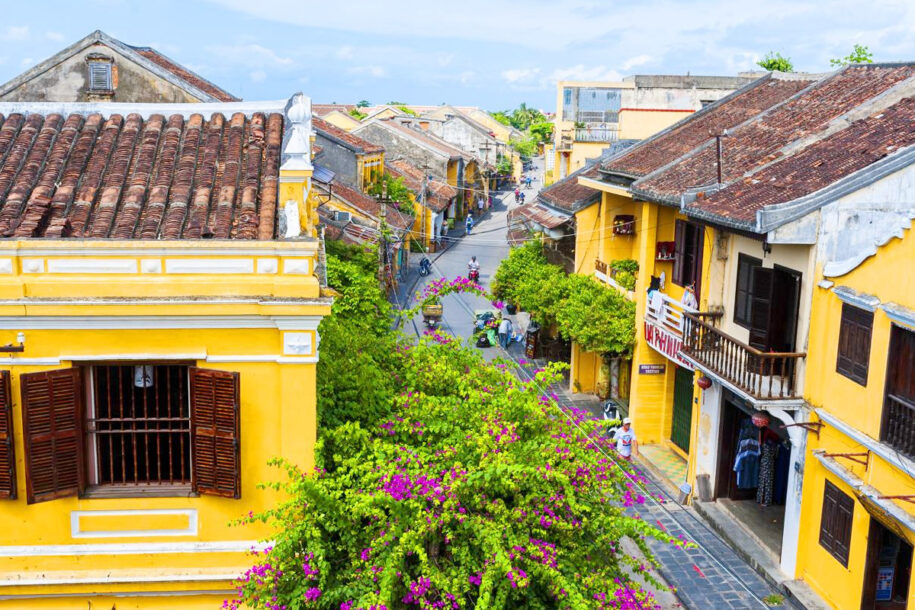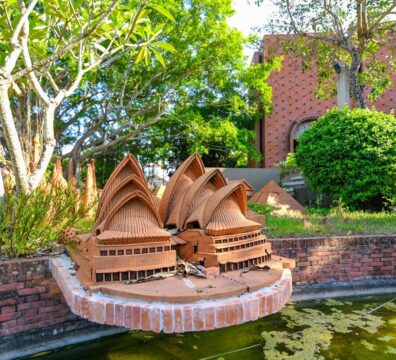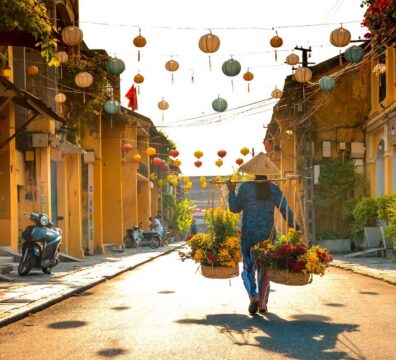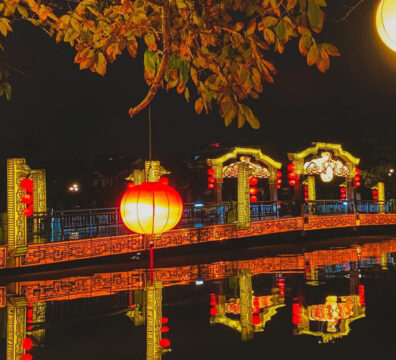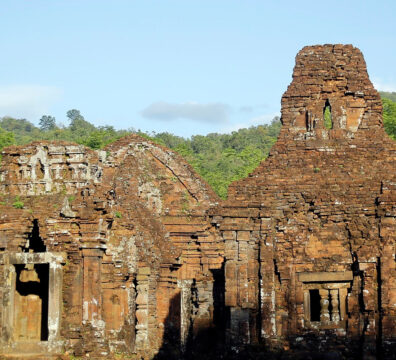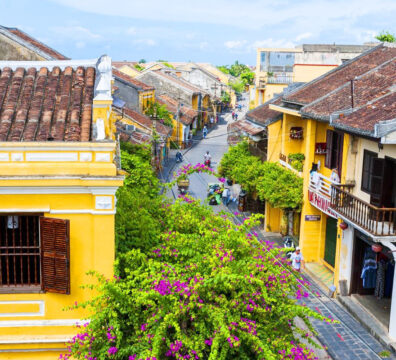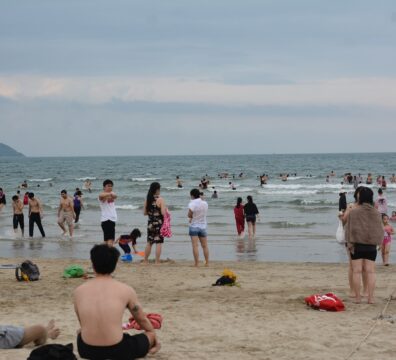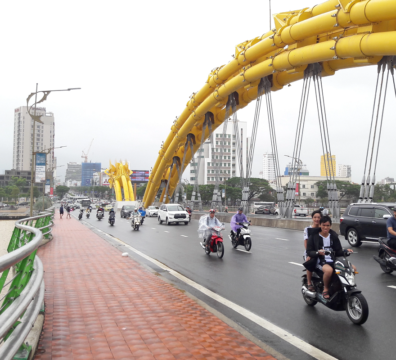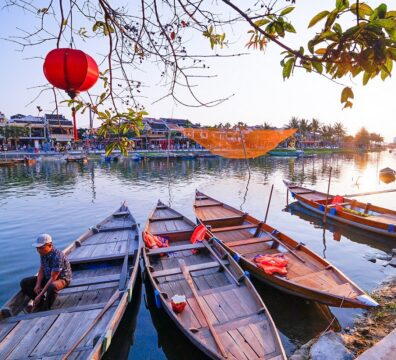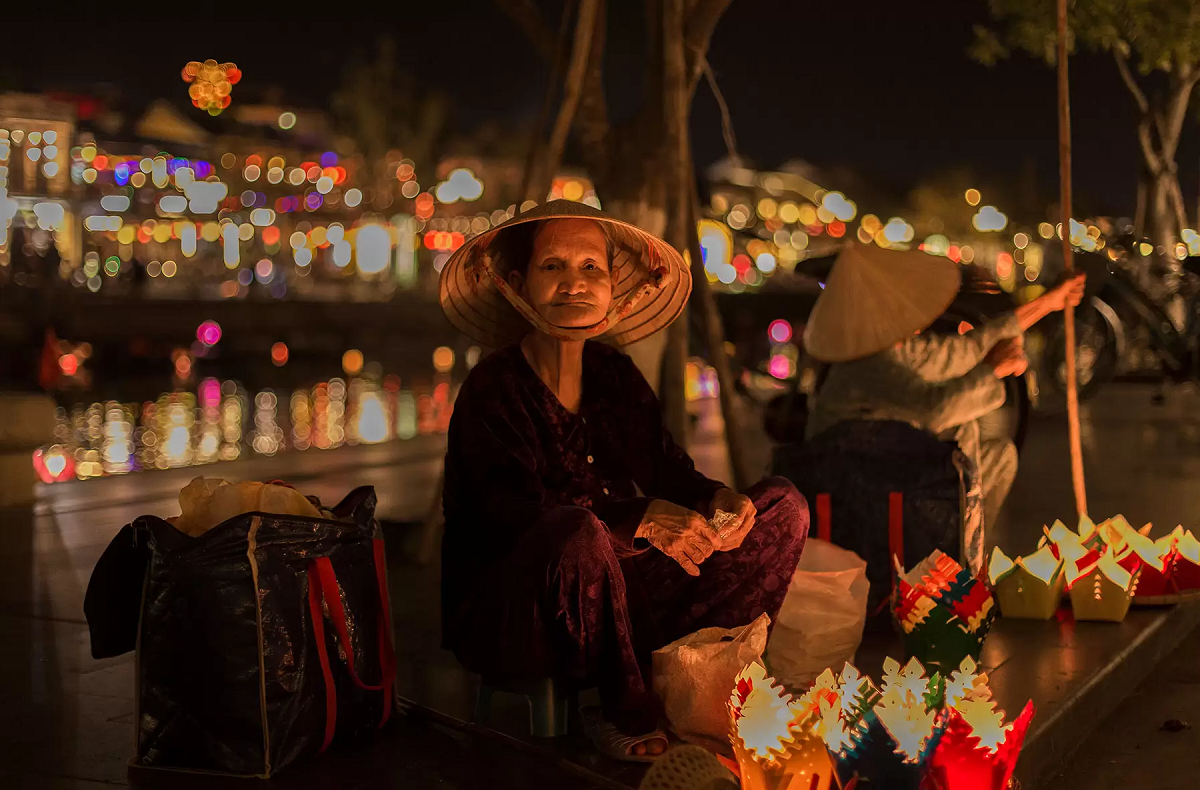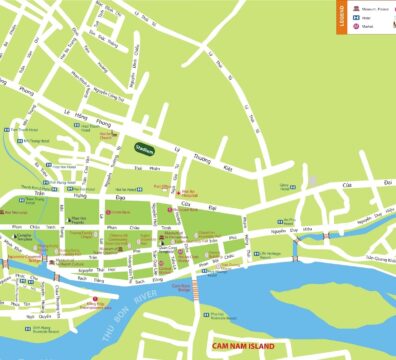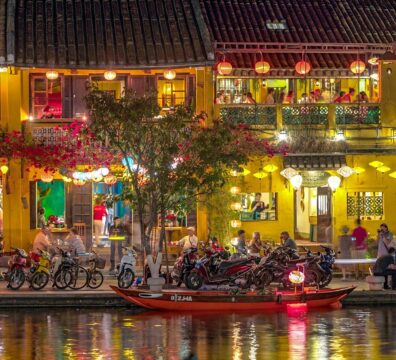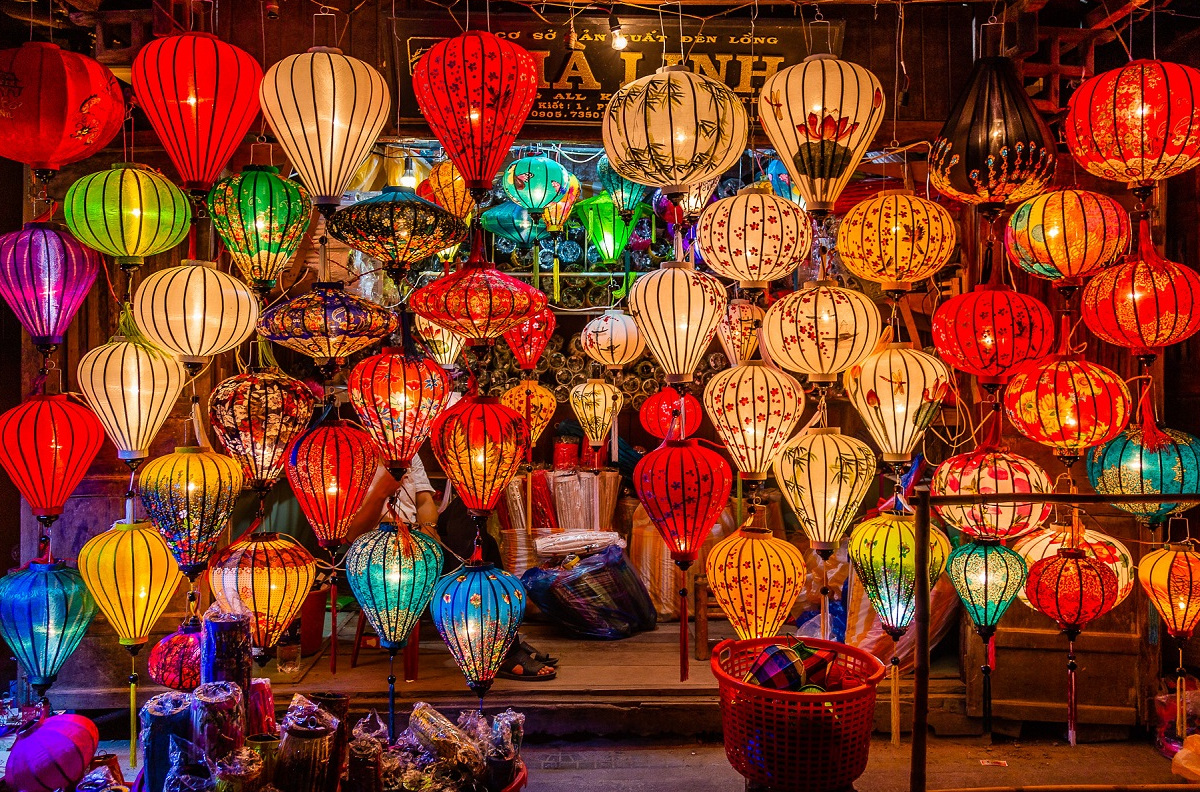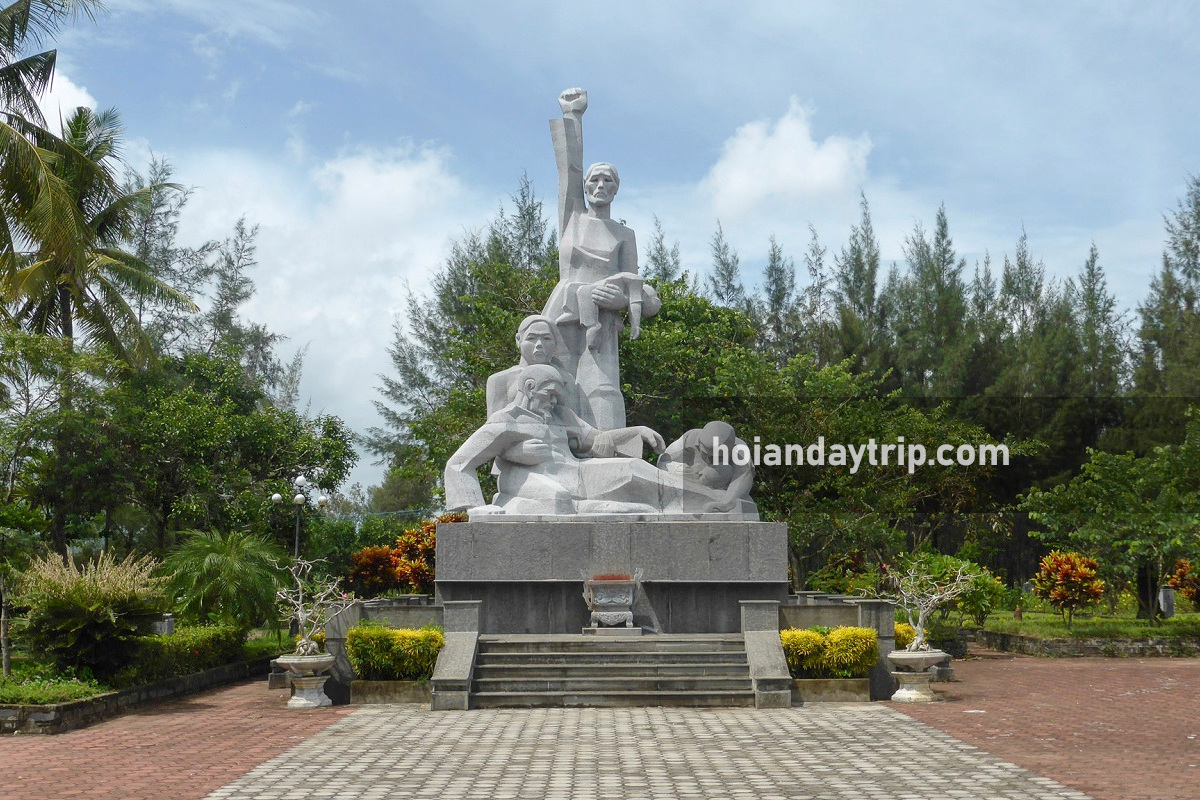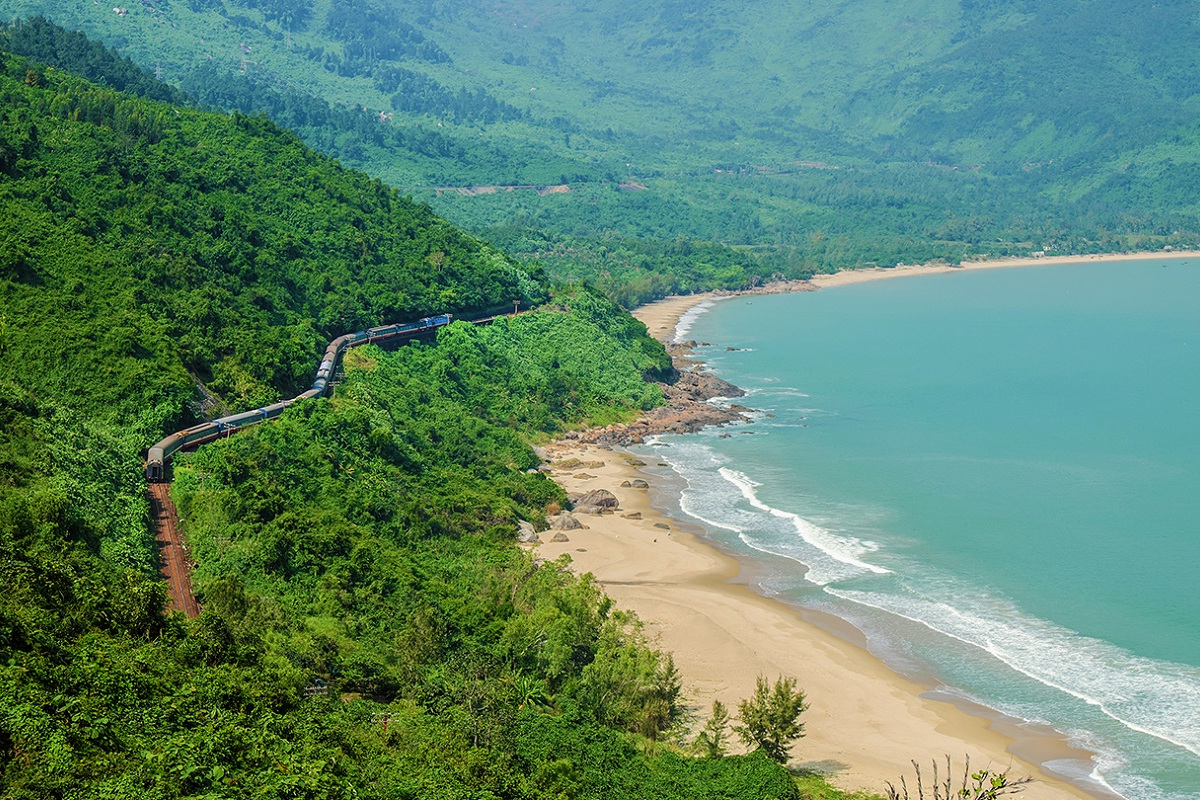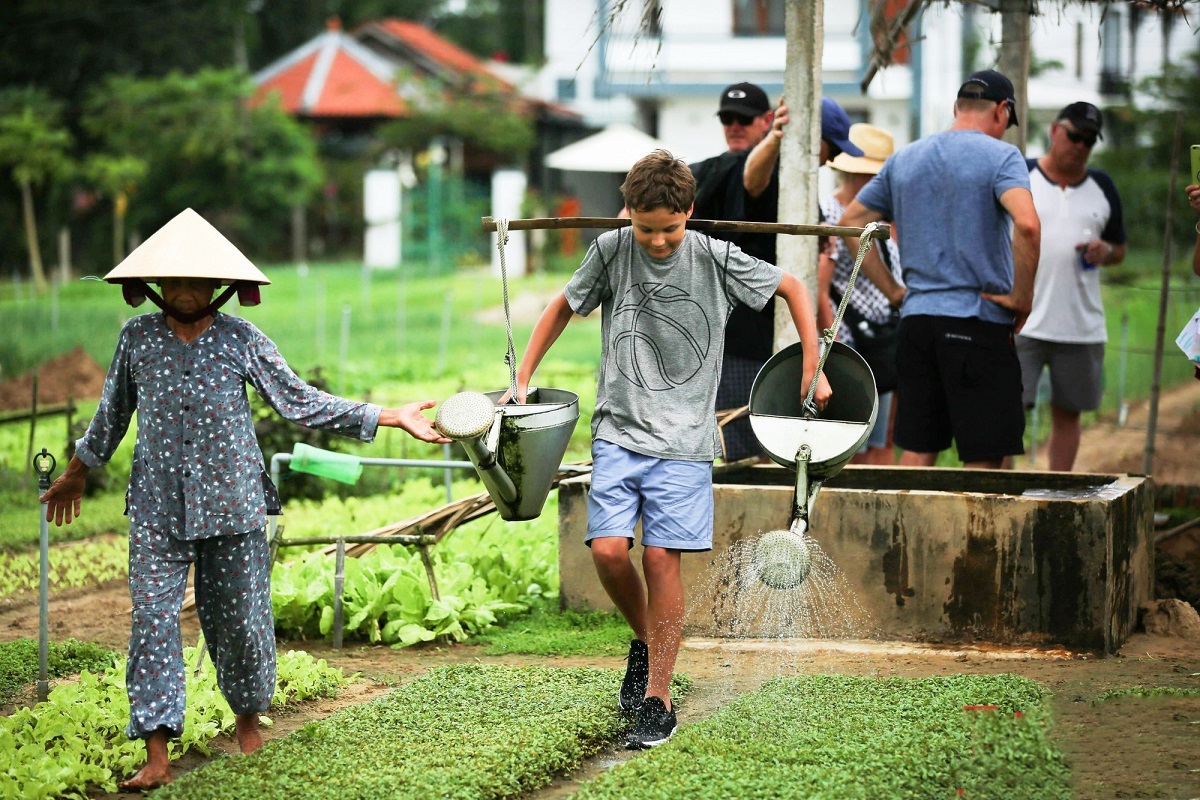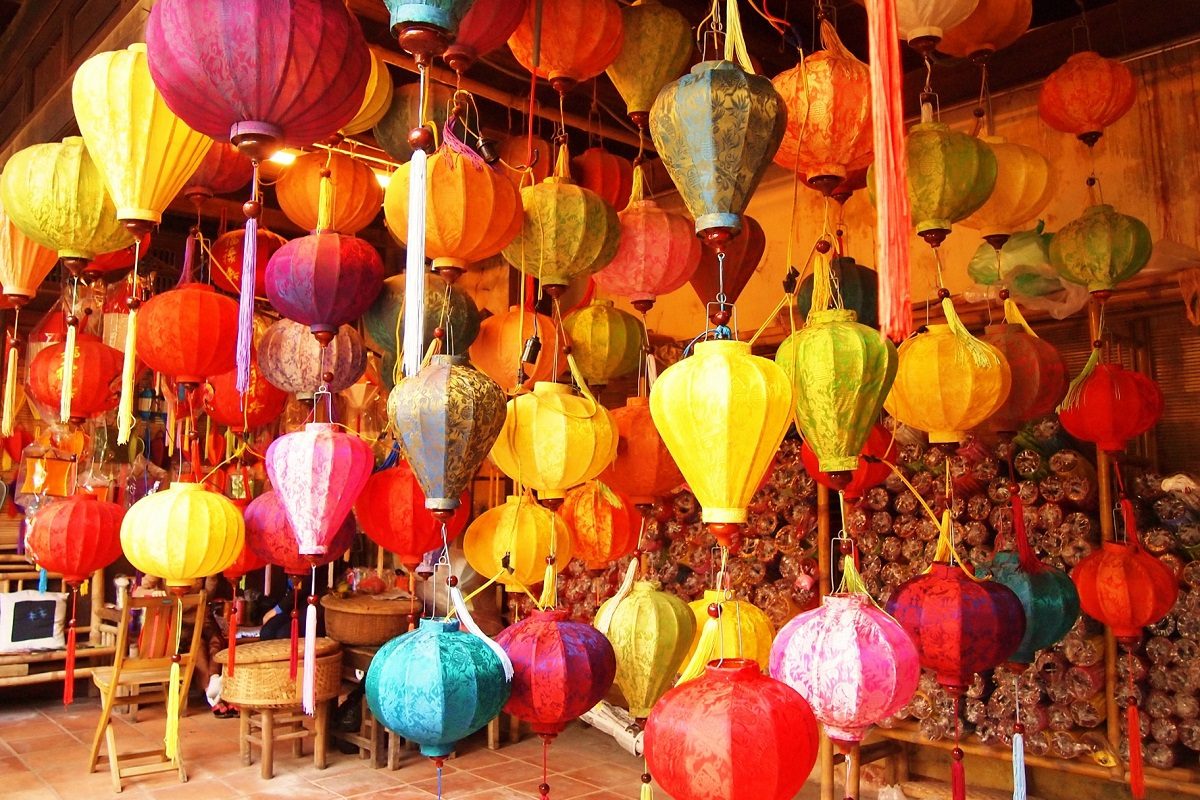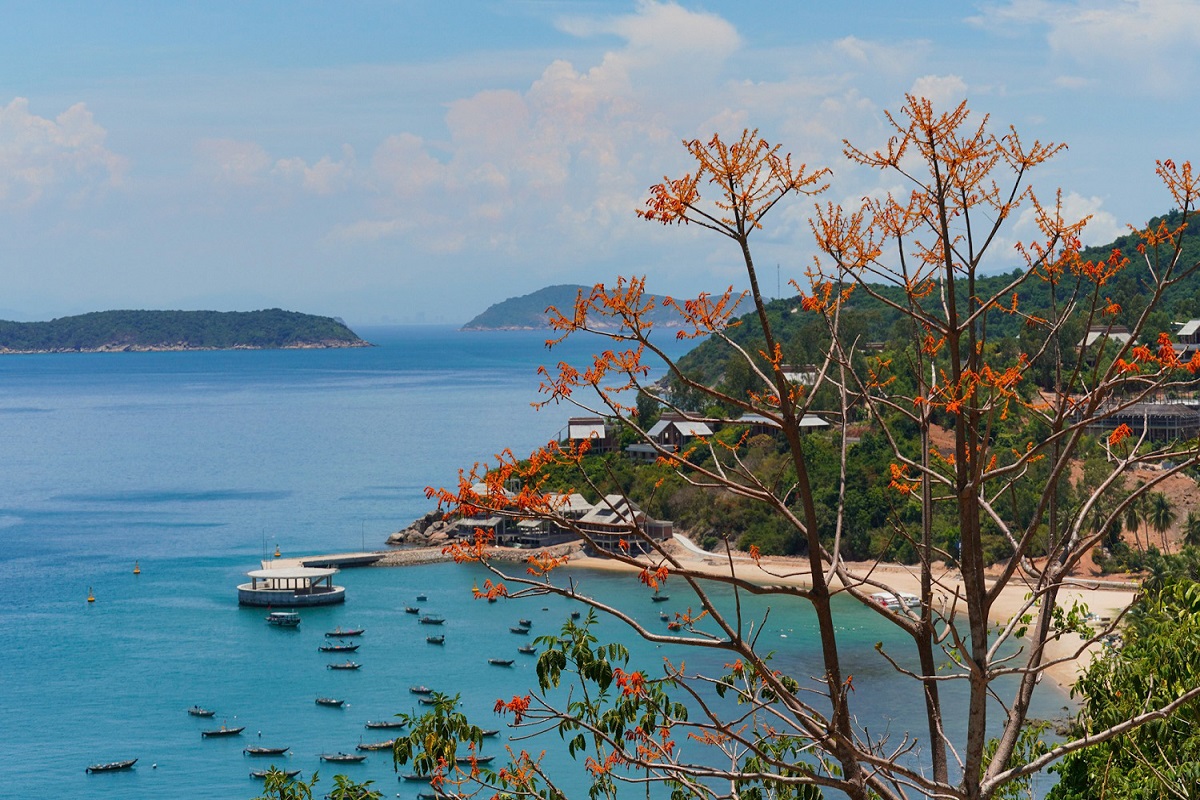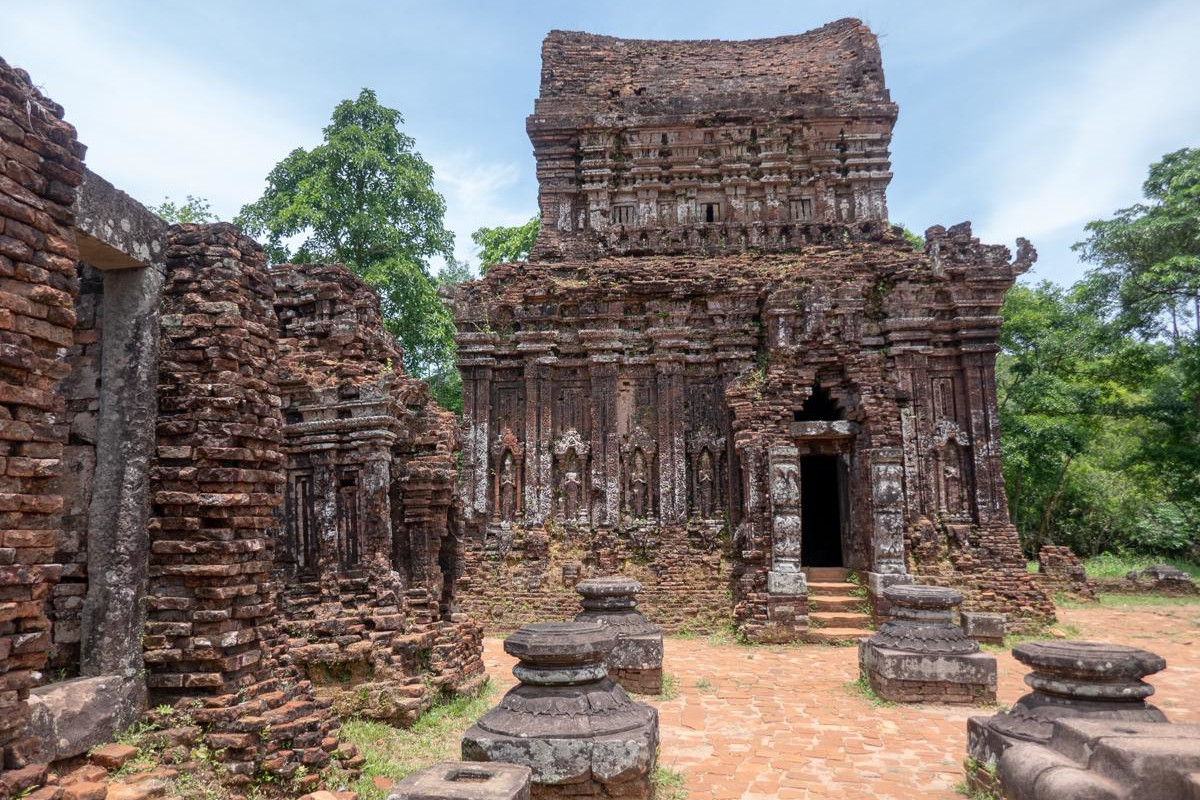Hoi An old town is friendly for pedestrians, especially during the time that motorized vehicles (scooters, cars, etc) are prohibited to move around its heritage quarters. That is safe for tourists and they also enjoy the charm and atmosphere of the Unesco world heritage town.
During the ”walking hours”, people are allowed to ride bicycles also. However, the best way to visit Hoi An is still by foot. While roaming around it, visitors can see up close century-old buildings, trading quarters with colorful lanterns, bustling markets, street foods, vendors, life of locals and even sunrise or sunset. In addition, it’s easier for taking pictures and talking with people. So, there is no doubt that a walking tour (by yourself or with a local guide) is a must in Hoi An.
In this article, we recommend the best route for self guided travelers, in order to fully explore Hoi An ancient town. Highlights or points of interest on each street are also provided, to make sure that everything is known. They may be historical sites, museums, theatres, workshops, shops, street street spots, and more. Generally, they represent different sides of the town and live within it.
Read also:
- Hoi An Bicycle Routes
- Motorbike Routes in Hoi An
- Travel Guide to Hoi An’s Beaches
- Hoi An Countryside: Villages, Rice Fields and Tours
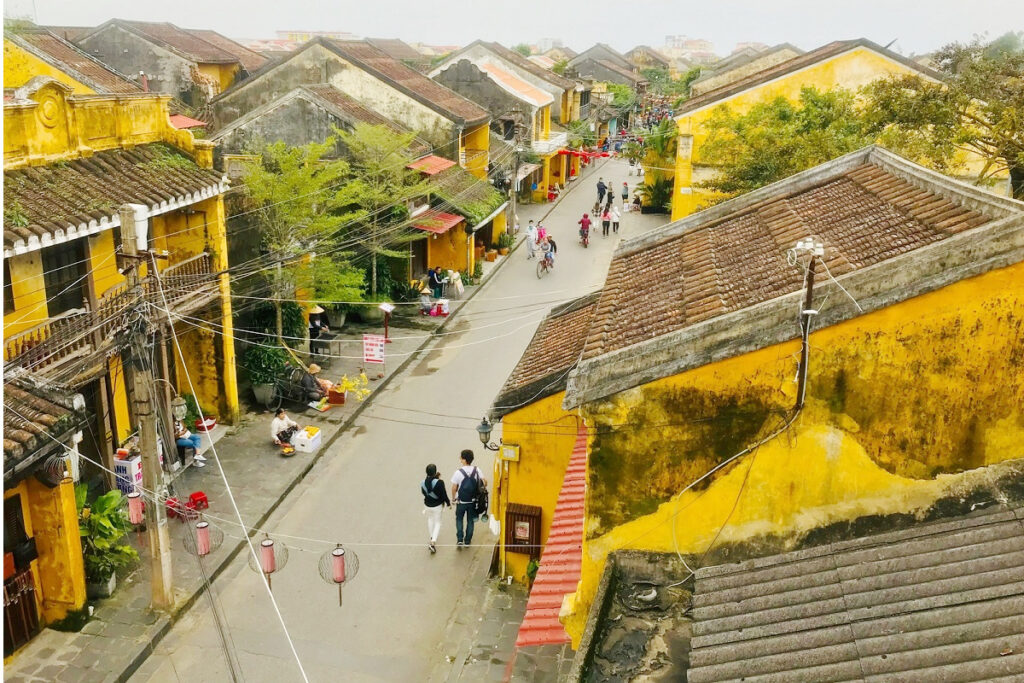
Table of content
- 1 Brief History Introduction of Hoi An Ancient Town
- 2 The Best Area to Walk: Hoi An Ancient Town
- 3 The Best Time to Walk: Non-Motorized Vehicles Hour
- 4 Hoi An Ancient Town Entrance Fee & Ticket
- 5 Hoi An Self Guided Walking Tour: Our Suggested Route
- 6 Highlights on Tran Phu Street
- 7 Highlights on Nguyen Thai Hoc Street
- 8 Highlights on Bach Dang Street
- 9 Highlights on Nguyen Thi Minh Khai Street
- 10 Highlights on Le Loi Street
- 11 Highlights on Cong Nu Ngoc Hoa Street
- 12 Highlights on Hai Ba Trung Street
- 13 Highlights on Hoang Van Thu Street
- 14 Guided Hoi An Ancient Town Walking Tour
- 15 Hoi An Ancient Town Tour Guide
- 16 Hoi An Self Guided Walking Tour Map
- 17 Related Posts
- 18 Bach Ma National Park: Hiking, Trekking in Da Nang and Hoi An
- 19 Hoi An Wet Season: What to Do in Hoi An When It Rains?
- 20 Thanh Ha Terracotta Park
- 21 Vinwonders Nam Hoi An Theme Park (formerly Vinpearl Nam Hoi An)
- 22 Am Phu Cave (Hell Cave) – Things to Do in Da Nang
- 23 Hoi An or Hue: Which is Better?
- 24 The Official Hoi An Travel Guide (MUST READ)
- 25 The Hoi An Market (Hoi An Central Market) Complete Guide
- 26 Hoi An Memories Show: The Best of Hoi An Impression Theme Park
- 27 Hoi An Bridge: Famous Bridges in Hoi An
- 28 How to Get From Hoi An to My Son Sanctuary
- 29 Hoi An’s Chinese Assembly Halls and Chinese Temples
- 30 Hoi An Walking Tours: Heritage, Foods, Photography & Locals
- 31 Hoi An Self Guided Walking Tour – Hoi An On Your Own
- 32 How to Visit Golden Bridge Vietnam
- 33 Unique Experiences in Hoi An and Why?
- 34 An Bang Beach: A Guide to Hoi An’s Best Beach
- 35 Experiences in Hoi An: Get Insight Into Hoi An’s Local Culture
- 36 Things to Do in Ba Na Hills Besides Golden Bridge
- 37 Hoi An Nightlife: What to Do in Hoi An At Night?
- 38 Hoi An Countryside: Villages, Rice Fields & Tours
- 39 How to Get to Golden Bridge From Hoi An
- 40 Hoi An Entrance Fee: Old Town, Golden Bridge, My Son, More
- 41 Hoi An Airport: Everything You Need to Know
- 42 Hoi An Lantern Boat Ride on Hoai River
- 43 Hoi An Private Car and Driver
- 44 What to Do in Hoi An Ancient Town
- 45 Da Nang and Hoi An Itinerary for Visitors Staying Overnight in Hoi An
- 46 Hoi An 3 Day Itinerary: A Travel Plan for 3 Days in Hoi An
- 47 Hoi An Free Things to Do: Budget Travel in Hoi An Vietnam
- 48 Hoi An One Day Itinerary: A Travel Plan for One Day in Hoi An
- 49 Hoi An Half-Day Tours: Guide to Half Day Trips From Hoi An
- 50 Hoi An Day Tours: A Guide to Best Day Trips From Hoi An
- 51 Hoi An Beach: A Guide to All Beaches in Hoi An Vietnam
- 52 Hoi An Food Specialties
- 53 How to Get From Hoi An to Da Nang
- 54 Hoi An Cheap Things to Do: All Solo Travelers Need to Know
- 55 Hoi An Best Things To Do: Recommendations from Local Experts
- 56 Hoi An Things to Do: All What Can You Do in Hoi An Vietnam
- 57 Hoi An Things Not to Miss: A Guide to Must Do in Hoi An
- 58 Hoi An or Da Nang: Which is Better for First Time Visitor?
- 59 Hoi An Pottery Village: A Guide to Thanh Ha Pottery Village
- 60 Hoi An Ancient Town Tour
- 61 Hoi An Old Town Ticket: Price, Sellers, Included Sites, More
- 62 My Son Sanctuary Tour
- 63 Hoi An Lanterns: Festival, Making Class, Where to Buy, More
- 64 Hoi An Best Area to Stay: Guide to Where to Stay in Hoi An
- 65 Hoi An Weather by Month: Guide to Hoi An Monthly Weather
- 66 Hoi An River Cruise: Guide to The Best Boat Tour in Hoi An
- 67 Hoi An Old Town Boats: Guide to Boat Rides in Hoi An Town
- 68 Hoi An 2 Day Itinerary: Traveler Guide to 2 Days in Hoi An
- 69 Cham Island Hoi An
- 70 Hoi An Basket Boat Ride
- 71 Hoi An Coconut Village: A Guide to Cam Thanh Coconut Village
- 72 Hoi An Cham Temples: My Son Sanctuary & Quang Nam Temples
- 73 How to Get from Da Nang Airport to Hoi An
- 74 Da Nang to Hoi An: Best Da Nang Airport Transfer and More
- 75 Hoi An Tour Guide: How to Find a Private Tour Guide in Hoi An
- 76 Hoi An Ancient Town Attractions
- 77 Hoi An Old Town Map
- 78 Tra Que Vegetable Village
- 79 Guide to Hoi An Lantern Festival – Hoi An Full Moon Festival
- 80 Hoi An Night Market: A Thing to Do in Hoi An at Night
- 81 My Son Sanctuary Travel Guide
- 82 Hoi An Old Town Unesco World Heritage – Hoi An Travel Guide
- 83 Featured Tours and Experiences
- 83.0.1 Bach Ma National Park Tour from Hue
- 83.0.2 Bach Ma National Park Tour from Da Nang/Hoi An
- 83.0.3 Hoi An Sunrise Fish Market Tour
- 83.0.4 My Lai Massacre Tour
- 83.0.5 Golden Bridge/Ba Na Hills & Hoi An Tour
- 83.0.6 Hoi An Instagram Tour
- 83.0.7 Ky Anh Tunnel & Tam Thanh Mural Village Tour
- 83.0.8 Da Nang to Hue Motorbike Tour with Hai Van Pass & Easy Rider (1 Way)
- 83.0.9 Hue to Da Nang Motorbike Tour with Hai Van Pass & Easy Ride (1 Way)
- 83.0.10 Hue to Hoi An Motorbike Tour with Hai Van Pass & Easy Rider (1 Way)
- 83.0.11 Hoi An to Hue Motorbike Tour with Hai Van Pass & Easy Rider (1 Way)
- 83.0.12 Tra Que Vegetable Village Tour with Cooking Class
- 83.0.13 Ba Na Hills Half Day Tour from Hoi An
- 83.0.14 Marble Mountain & Hoi An Day Tour from Da Nang Port
- 83.0.15 Hue Day Tour from Chan May Port with Lunch
- 83.0.16 Marble Mountain & Hoi An Tour from Chan May Port
- 83.0.17 Ba Na Hills/Golden Bridge Tour from Da Nang Port
- 83.0.18 Ba Na Hills/Golden Bridge Tour from Chan May Port
- 83.0.19 Golden Bridge Private Tour with Ba Na Hills & Lunch
- 83.0.20 Ba Na Hills Afternoon Tour with Golden Hands Bridge
- 83.0.21 Ba Na Hills Private Tour with Golden Hands Bridge
- 83.0.22 Ba Na Hills Half Day Tour with Golden Bridge
- 83.0.23 Ba Na Hills Early Morning Tour to Beat the Crowds
- 83.0.24 Golden Bridge and Ba Na Hills Night Tour
- 83.0.25 Golden Hands Bridge Tour In Sunrise or Sunset (1/2 Day)
- 83.0.26 Cam Kim Island Bicycle Tour From Hoi An
- 83.0.27 Cham Island Tour From Hoi An (Group Tour)
- 83.0.28 Cham Island Tour From Da Nang (Group Tour)
- 83.0.29 Hoi An Vegetarian Food Tour
- 83.0.30 Hoi An Evening Walking Food Tour with Local Foodie
- 83.0.31 Private Hoi An Basket Boat Tour (Shuttle Bus, Bicycle, Bike)
- 83.0.32 Half-day Am Phu Cave Tour (Private)
- 83.0.33 Hoi An Countryside Tour by Electric Car or Bike
- 83.0.34 Da Nang Tour Package From Singapore
- 83.0.35 Hoi An Evening Tour From Da Nang with Lantern Boat Ride
- 83.0.36 Hoi An Walking Food Tour Through Laneways
- 83.0.37 My Son Sanctuary and Hoi An Old Town Tour
- 83.0.38 My Son Day Trip From Hoi An including Marble Mountains and Basket Boat
- 83.0.39 Half Day Hoi An City Tour With River Cruise
- 83.0.40 Son Tra Peninsula Tour with Marble Mountains (Private/Small Group)
Brief History Introduction of Hoi An Ancient Town
Hoi An is a historic trading port in central Vietnam. It’s firstly inhabited by people who owned the Sa Huynh culture (1,000 BC – 200) and then Cham people. The Chams lived and established a port city in the same area (it’s called Champapura). Archaeologists found good-quality products that are produced in Persia, China and other countries.
From 15th to 19th centuries, Hoi An played its role as a major destination for merchants in Southeast Asia. They came from many countries, including China, Japan, France, Netherland, England, and more. And they seek local products such as silk, spices, ceramics. Wealth of the town was at its peak in 17th and 18th centuries. That is the reason why the most grand buildings were constructed in this golden period, including many religious spots. Due to being a meeting place between different nationalities, the culture here is mixed and becomes unique in Vietnam. Portuguese catholic missionaries also arrived in Hoi An to introduce their religion.
Sadly, in the late 19th century, the commerce in Hoi An town declined and its role was gradually replaced by Da Nang harbour. One of the reasons that caused this turning point is Nguyen king’s decision in which he requested ships from the west to stop at Da Nang before moving to Hoi An. He might be worried about missionary activities and military power of the westerners. Later, the French built an airport, train station and a state-of-the-art transport network, making Da Dang better for business.
In the 20th century, the French and Americans chose Hoi An to be the capital city of Quang Nam province due to its strategic location. In 1950 (after the Vietnam war), this town lost its administrative and political role when the leaders decided to base in Tam Ky city. By that, they could have a stronger focus on preservation of Hoi An because many pressures were removed.
In 1999, the Hoi An ancient town was inscribed as a Unesco world heritage site thanks to its unique and outstanding values. Since then, it has been known by tourists all over the world. There is no doubt that now, this charming town is a top place to visit in Vietnam.
Read also: My Son Sanctuary Travel Guide
Contact us by +84968009827 (whatsApp available) or centralvietnamguide@gmail.com to book tours and private transfers to Hoi An Ancient Town. We have a discount for families and groups.
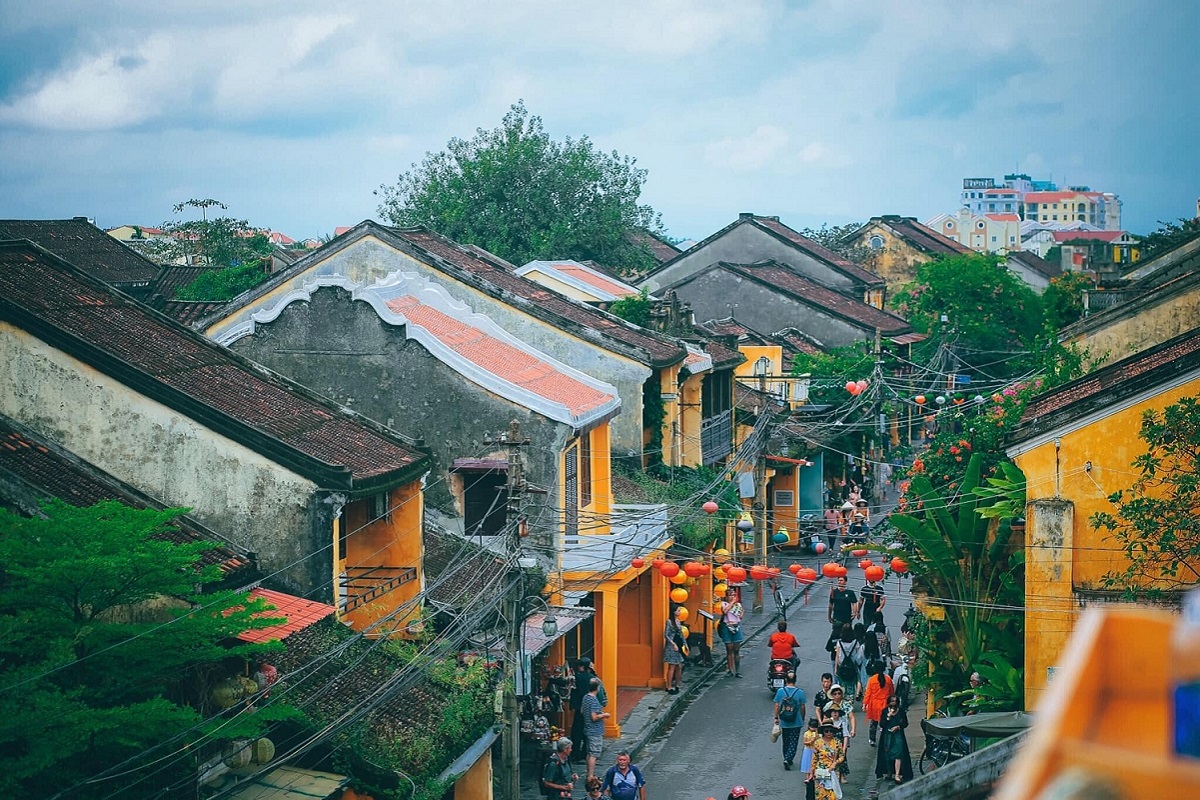
The Best Area to Walk: Hoi An Ancient Town
The Hoi An ancient town is the best area in Hoi An to explore by walking. It’s a 30-hectare area and is home to more than 1,100 buildings on the bank of the Thu Bon river. Interestingly, the local house’s walls here have the same color, yellow. Remains of different nationalities, from east to west, are still visible and well protected in this grid plan town. It’s also famous for colorful lanterns and blooming bougainvillea, making it so photogenic. Furthermore, Hoi An becomes lively and spectacular when it’s filled by shimmering lights of lanterns. With a slow pace, walking allows visitors to enjoy the beauty.
As the historic core of modern Hoi An, it’s absolutely convenient to get there from the hotel. Then, travelers can have a free walk through its historic quarters, sightsee cultural landmarks, try delicious foods and take some nice pictures. Specifically, the city designates the heritage to be friendly to pedestrians and bicycle riders. Many hours a day, motorbikes, cars and other motorized vehicles aren’t allowed to move around. That’s so wonderful!
Read also: Beaches in Hoi An
Contact us by +84968009827 (whatsApp available) or centralvietnamguide@gmail.com to book tours and private transfers to Hoi An Ancient Town. We have a discount for families and groups.
The Best Time to Walk: Non-Motorized Vehicles Hour
The best time to walk around the Hoi An ancient town is within “non-motorized vehicles hour” or simply, walking street hours by locals. In the morning, it’s from 9 to 11:30 and in the afternoon and evening, from 3 to 9:30. During these periods, motorcycles, cars and whatever used motor to move are not allowed to go around. It’s not difficult to see people walking with their bikes in town.
So, the good time to start a Hoi An self-guided walking tour should be in these pedestrian-friendly times. Travelers will feel safe while roaming around streets and taking pictures. Bicycles and cyclos still move through crowds, but with a pace that is not too fast. We recommend walking through laneways to avoid the traffic, even scammers and look at more authentic life of locals (especially when you you with kids). It’s possible to reach everywhere in Hoi An’s old town by these backstreets.
However, visiting Hoi An in the early morning (particularly before 9 pm) is still stunning. Somehow, it’s better than the rest of the day if travelers want to see the real life of the locals. Local people have breakfast and coffee on the street or bustling markets and vendors with exotic products are what they look for. If coming to the town earlier, the sunrise or sunbeam definitely supports amazing pictures. In the afternoon onwards, Hoi An is so touristy.
Read also: The Best Time to Visit Da Nang
Contact us by +84968009827 (whatsApp available) or centralvietnamguide@gmail.com to book tours and private transfers to Hoi An Ancient Town. We have a discount for families and groups.
Hoi An Ancient Town Entrance Fee & Ticket
Main article: Hoi An Old Town Ticket
Hoi An Old Town Entrance Fee
The cost of Hoi An old town entrance fee is 120,000 Vietnamese dong (around 5,2 US dollars). Local tourists or Vietnamese passport holders pay less, 100,000 VND (around 4,3 US dollars). This entry fee is charged for tourists who visit the Unesco world heritage site area only (see the map below to know the boundaries). It’s important to raise funds to preserve the heritages and give back to locals.
Inclusions of Hoi An Old Town Entrance Fee
If holding a Hoi An old town ticket, tourists can “officially” enter the Unesco-inscribed world heritage site area. In addition, there are more than 20 places around the town where they can visit, to learn about history, unique local culture and architecture. This list includes the Japanese covered bridge – the emblem of Hoi An, five Chinese assembly halls and one Chinese temple, five museums, two family temples, communal houses and Quan Cong temple. At 66 Bach Dang street, the Hoi An traditional art performance theatre, a cultural show is provided. It’s absolutely interesting to watch.
Ticket holders only can sightsee 5/20 places. Besides the theatre, we recommend going to the Japanese covered bridge, Fujian assembly hall, Tan Ky house, and a museum that has a theme you are interested in.
Where to Buy Hoi An Old Town Ticket
Tourists can come to counters (booths) in main roads leading into the world heritage area or walking streets. Right by the Japanese bridge – Tran Phu street’s entrance, there is one. See the map below to know the nearest seller to you.
Read also: Hoi An Entrance Fee (All Places)
Contact us by +84968009827 (whatsApp available) or centralvietnamguide@gmail.com to book tours and private transfers to Hoi An Ancient Town. We have a discount for families and groups.
Hoi An Self Guided Walking Tour: Our Suggested Route
We recommend starting the walking tour from the Precious Heritage Art Museum Gallery by Rehann photographer at 26 Phan Boi Chau St. This is the best known private museum or gallery in town thanks to amazing pictures and the traditional costume of all ethnics of Vietnam. It opened in January 2017.
After that, travelers should walk along Phan Boi Chau St (known as the French quarter) and then turn right to enter Hoang Dieu St. At its crossroad with Tran Phu St, can buy a ticket. Don’t forget to take a free map there. The Fabric/Cloth market is just a few steps away from this place. Travelers can spend time at a tailor and get some bespoke clothings like suits or dresses.
Just walking along Tran Phu St, through the Japanese covered bridge and then along Nguyen Thi Minh Khai St until seeing the Japanese red-seal ship. This is exactly 1-kilometer-long walk. Travelers will pass by Chinese temples, Hoi An central market, and museums (use your ticket to stop at wherever you like to see!). The Fujian assembly hall is the most popular place.
Cong Nu Ngoc Hoa is the next street, and after the wooden bridge, just walking along Nguyen Thai Hoc St. This walk is in the opposite direction to the first one. In the end, travelers can go to the Hoi An central market, to see diverse merchandise and taste local dishes. Outside, fresh vegetables, herbs and fruits are sold. Those who love photography definitely hunt for some unique pictures.
The best walk may be from Hoi An market to An Hoi bridge, on Bach Dang St running along the river. In the sunset or evening, that is fantastic. Then, going across the bridge (not Japanese bridge) and coming to the other bank. The busiest night market is there and it’s perfect to end the walking tour with a cold beer in Nguyen Phuc Chu St.
Read also: Visit the Golden Hands Bridge by Yourself
Contact us by +84968009827 (whatsApp available) or centralvietnamguide@gmail.com to book tours and private transfers to Hoi An Ancient Town. We have a discount for families and groups.
Highlights on Tran Phu Street
Tran Phu street is 700 meters long, between the Japanese covered bridge and the Hoi An fabric market. In some periods, it’s called the Japanese bridge road. Historically, the first trading quarter of Hoi An port was established. In the rainy season, it’s not flooded thanks to it’s on higher ground. These are highlights on Tran Phu street that visitors should not miss:
– Chinese temples and assembly halls: Cantonese Assembly Hall (176 Tran Phu), Fujian Assembly Hall (46 Tran Phu), Quan Cong Temple (24 Tran Phu), Hainan Assembly Hall (10 Tran Phu), Tuy Tien Duong Minh Huong Temple (14 Tran Phu)
– Mot iced herbal tea: 150 Tran Phu, the most special local beverage made of different fresh ingredients (lemongrass, ginger, tea leaves, etc), giving a refreshing flavour to drinkers. Eco-friendly grass straws are used.
– Kazimierz Kwiatkowski memorial statue: to commemorate a Polish architect and conservationist who stayed in central Vietnam many years, to preserve local cultural heritages, especially My Son and Hoi An.
– Rooftop coffee shops: Two popular places are Faifoo Coffee at 130 Tran Phu, 92 Station at 92 Tran Phu. At their top, visitors can see the town from above (higher view from 92) and have some kool pictures. Faifoo is firstly opened in Hoi An.
– Museums: Museum of Sa Huynh Culture (by the bridge, 149 Tran Phu), showcasing relics dated back from 1,000 BC in Hoi An, and Museum of Trade Ceramics (80 Tran Phu) with a collection of ceramic produced for exportation, including discoveries from shipwrecks. Ticket is required. Museum of Spices (57 Tran Phu) will be opened soon.
– Hoi An central market: visitors can see a well where people have used fresh water to drink, and the front of the market, a popular photo spot. In the late afternoon, street food vendors are around here, selling delicious pork barbecues wrapped in betel leaf.
Tran Phu (1904-1931) is a Vietnamese male revolutionary and the first general secretary of the Indochina Communist Party ever. He was borned in Phu Yen and died in Saigon (now Ho Chi Minh city), both in the south of Vietnam.
Read also: Hoi An Basket Boat Ride
Contact us by +84968009827 (whatsApp available) or centralvietnamguide@gmail.com to book tours and private transfers to Hoi An Ancient Town. We have a discount for families and groups.
Highlights on Nguyen Thai Hoc Street
Nguyen Thai Hoc street stretches 550 meters from An Hoi bridge (Bach Dang street) to the Hoi An central market. On the map, it’s parallel to Tran Phu street in the north and the river to the south. Because there are a lot of lanterns in it, its nickname is the “lantern town”. These are highlights in Nguyen Thai Hoc street:
– Tan Ky House: this merchant’s house was built in 17th century, and is one of the best preserved houses in Hoi An. Visitors will listen to history from a guide (a family member) and see an architecture that has been nearly unchanged since its birth. The entrance is by a main street while another door opens to the river where boats upload/load the cargo. This house is a must see in town.
– Diep Dong Nguyen House: at the four-way intersection of Le Loi street, this house is originally a medicine plant shop owned by the Diep family. Later, people sell lamp oil, silk and books. Although the house doesn’t open for tourists, its front alone is also interesting to see and photograph.
– Museum of Traditional Medicine: a collection of 200 artifacts is showcased in two storeys of this house. Visitors have a deeper knowledge about traditional medicine of Vietnamese and the Chinese (called thuoc nam and thuoc bac respectively).
– Museum of Folklore: visitors have an insight into different folk performances, art, handicraft and professions in Hoi An. It’s opened in 2005, and stands by the cyclo riders station.
Nguyen Thai Hoc is a Vietnamese revolutionary who was the founding leader of the Vietnamese Nationalist Party (1927). He is borned in 1902 and died in 1930 after being captured and executed by French colonists. Him and other members of the party led the Yen Bai mutiny but then failed.
Read also: My Son Sanctuary Tours
Contact us by +84968009827 (whatsApp available) or centralvietnamguide@gmail.com to book tours and private transfers to Hoi An Ancient Town. We have a discount for families and groups.
Highlights on Bach Dang Street
Bach Dang street is 750 meters long, running along the Hoai river (or Hoi An river). To the west, it encounters Cong Nu Ngoc Hoa street at a wooden bridge and on the other side, Hoang Dieu street at the Fabric market. It’s also a quay where boats and ships dock, from past to now. Because of being right next to the river, this lovely waterfront is frequently flooded during the rainy season. No doubt, it’s the most photographed street of Hoi An. These are points of interest in Bach Dang street:
– The Hoi An Traditional Art Performance Theatre: visitors can use “Hoi An old town ticket” to enter and watch a show of several performances. Each watcher has a card to try how lucky he/she is in a traditional game called Bai choi.
– (At night) Lantern boats and sellers: travelers and photographers really enjoy strolling around Bach Dang street after the sunset, to see and take pictures. There are some ticket booths here to buy tickets for lantern boat rides that will be in 20 minutes. Read further details in Hoi An lantern boat ride on Hoai river.
– (At night) Night market around the Central market: more than 100 stalls open to sell a variety of goods after sunset. Visitors may buy similar things but with a cheaper price than the famous night market on Nguyen Hoang street (on the other side of An Hoi bridge). Street foods are available.
– Rooftop restaurants: some venues have a balcony or rooftop overlooking the canal and nearby quarters, providing the best view ever in Hoi An. On the menu, it’s possible to see Vietnamese and western cuisines, besides various beverage options.
– Performances of Bai choi: Bai Choi is declared to be world’s cultural intangible cultural heritage by Unesco in 2017. Now, it’s live every night in an open-air stage by An Hoi bridge. Besides locals, tourists also have a chance to join this folk bingo game and listen to Vietnamese songs from artists. The host speaks English.
About the name of the street, Bach Dang is a river in northern Vietnam (somewhere not too far from Halong bay). Here, Vietnamese people defeated Chinese invaders twice and Mongolian invaders once. The invaders accessed the capital city of Vietnam (now Hanoi) by this river because it’s the shortest waterway from the sea. For that reason, it represents heroic stages in history and many streets are named the same, especially riverside ones.
Read also: Cam Kim Island Bicycle Tour
Contact us by +84968009827 (whatsApp available) or centralvietnamguide@gmail.com to book tours and private transfers to Hoi An Ancient Town. We have a discount for families and groups.
Highlights on Nguyen Thi Minh Khai Street
Nguyen Thi Minh Khai is a 350-meters long street, with a point as the Japanese covered bridge. Historically, it might be the Japanese town while the opposite side (Tran Phu st) was the China town. Its name is a female revolutionary borned in 1910, one of the leaders for the Indochina Communist Party and executed in 1941 in Ho Chi Minh city by French colonists. She was the wife of Tran Phu. These are points of interest in Nguyen Thi Minh Khai street:
– The Japanese red-seal ship: Nagasaki authorities gave this merchant sailing ship to Hoi An in 2017 as a gift, to celebrate the friendship between Vietnam and Japan. A red wooden gate nearby is also built.
– Cam Pho communal house: this Vietnamese village’s temple is used to worship the communal god (called thanh hoang lang) and to celebrate communal activities, like festivals.
– Nguyen Tuong family chapel: each family has one chapel to worship the ancestors in Vietnam (the whole village has one too). This belongs to the Nguyen Tuong family that has many members who served for the kings with a high ranking. The next generations are also very talented, including famous writers, poems and more.
Read also: Hoi An Pottery Village
Contact us by +84968009827 (whatsApp available) or centralvietnamguide@gmail.com to book tours and private transfers to Hoi An Ancient Town. We have a discount for families and groups.
Highlights on Le Loi Street
Le Loi is one of the main roads in Hoi An. It starts from the intersection of Tran Hung Dao street, near the Hoi An museum and ends at the river. Its name is a king who led Vietnamese people to defeat the ruling Chinese in 15th century. He became the emperor and the founder of Le So dynasty. The country’s wealth reached its peak in many aspects, during this era. There are points of interest in Le Loi St:
– Hoi An communal house: known as the Elephant temple because it has a couple of stone elephants before the entrance. It has been used to worship the ancestors of the Vietnamese Hoi An village.
Read also: Hoi An Temples and Pagodas
Contact us by +84968009827 (whatsApp available) or centralvietnamguide@gmail.com to book tours and private transfers to Hoi An Ancient Town. We have a discount for families and groups.
Highlights on Cong Nu Ngoc Hoa Street
Cong Nu Ngoc Hoa is 350 meters long, running by the edge of Hoai river. On the map, it’s parallel to Nguyen Thi Minh Khai street to the north. At one point, tourists can enter it from Cao Hong Lanh street and Song Hoai square, and at the other point, from the Japanese covered bridge. These are highlights that visitors should not miss:
– (At night) Outdoor dining places: Here, there are many tables set on the riverbank, allowing people to have a dining experience with a pretty view. That is a scene of uncountable lanterns, numerous boats, shimmering floating lanterns and chaotic crowds. The atmosphere is really engaging and happening. Food options include all Hoi An local specialty dishes (such as cao lau noodle, grilled pork with rice papers, etc) and are prepared in the kitchen of inner restaurants. Alcohol drinks are not available.
The name of the street, Cong Nu Ngoc Hoa is Ngoc Hoa princess in Vietnamese. Her life is linked to the history of Hoi An trading town. She is one of childs in Nguyen Phuc Nguyen lord’s family, and is married with a Japanese merchant in 1619. One year later, she lives with her husband in his hometown Nagasaki to run a business. Nowadays, local people there still memorize this couple in their traditional festival. They represent the partnership and friendship between Vietnamese and Japanese.
Another famous marriage in the area is between Huyen Tran, a Vietnamese princess and Che Man, a king of Champa kingdom. After it, the land is owned by Vietnamese people as the wedding present.
Read also: Thu Bon River Cruise
Contact us by +84968009827 (whatsApp available) or centralvietnamguide@gmail.com to book tours and private transfers to Hoi An Ancient Town. We have a discount for families and groups.
Highlights on Hai Ba Trung Street
Hai Ba Trung is a long road in Hoi An, connecting the Ancient town and An Bang beach, through some residential areas and rice fields. Walking area is between Phan Chu Trinh street and Bach Dang street (the river). The endest section is a small laneway, with a fresh-water well that is still in use. These are things not to miss along Hai Ba Trung street:
– Ba Mu temple gate: the last surviving temple used to worship Thien Hau, goddess of sea. Recently, it was reconstructed and quickly became famous then in social media. By night, it comes to light. Here, visitors can buy “Hoi An ancient town ticket”.
– Phap Bao pagoda: the largest Buddhist temple in the oldest part of Hoi An. Today, this peaceful place functions as the headquarter of the local Buddhist association. By that, the most important events (such as Buddha’s birthday) are solemnly celebrated here. Monks are living in houses by the main hall.
Read also: The Best Cao Lau in Hoi An
Contact us by +84968009827 (whatsApp available) or centralvietnamguide@gmail.com to book tours and private transfers to Hoi An Ancient Town. We have a discount for families and groups.
Highlights on Hoang Van Thu Street
Hoang Van Thu is a short road, stretching from the All-Chinese community assembly hall (Hoi quan Trung Hoa) to the river. It’s lined by bougainvillea and rangoon creeper flowers. These are points of interest in Hoang Van Thu street:
– Banh beo Ba Bay: a well-known street stall run by Ms Bay (meaning “seven”), selling banh beo – steamed rice cake in ceramic bowls, served with shrimp paste, topping and fried shallot, eaten with fish sauce and chilli. Additionally, banh bot loc or clear dumplings are also sold here, including for vegetarians. See other Hoi An food specialties.
– Cyclos: introduced into Vietnam in French colonial time, today cyclos become a popular vehicle to get around tourist cities. Each person pays 150,000 VND at least from the rider, to tour the town in 20 minutes. This ride is appropriate for elders who can’t walk too much or those who like to discover by a different way. Taking photos isn’t hard.
Hoang Van Thu (1906-1944) is one of the leaders of the Communist party of Indochina that was later unified with others to be the Communist party of Vietnam. He is a Tay people, in a farmer family. In 1943, he was captured by French and then jailed in Hoa Lo prison before being shooted.
Read also: How to Visit the Golden Bridge from Hoi An
Contact us by +84968009827 (whatsApp available) or centralvietnamguide@gmail.com to book tours and private transfers to Hoi An Ancient Town. We have a discount for families and groups.
Guided Hoi An Ancient Town Walking Tour
The best way to explore Hoi An ancient town is by foot and with a local guide. Your new friend, the guide will tell many stories and history and explain the local culture on the tour. Sure, just helping to deepen the understanding of visitors about Hoi An. Somehow, if traveling by yourself, you may miss them or not know many details like that.
Read also: Hoi An Private Car and Driver
Contact us by +84968009827 (whatsApp available) or centralvietnamguide@gmail.com to book tours and private transfers to Hoi An Ancient Town. We have a discount for families and groups.
Hoi An Ancient Town Tour Guide
If you need a private tour guide who is well-spoken in English, friendly and knowledgeable, please text us in whatsapp number +84968009827 or email centralvietnamguide@gmail.com. We can help.
Read also: Hoi An Tour Guide
Hoi An Self Guided Walking Tour Map
Related Posts
Bach Ma National Park: Hiking, Trekking in Da Nang and Hoi An
Two best places for trekking and hiking in and near Da Nang are Son Tra mountain (peninsula) and Bach Ma national park. Which one is better is actually personal because these
Hoi An Wet Season: What to Do in Hoi An When It Rains?
No beach, no pool, no outdoor adventures? What to do in Hoi An when it rains? This is a very popular question from travelers who come to Vietnam in the
Thanh Ha Terracotta Park
Between 15th and 19th centuries, Hoi An was one of major stopovers for sailing merchants to trade in Southeast Asia. Meanwhile, craftspeople in its Thanh Ha village produce high-quality pottery
Vinwonders Nam Hoi An Theme Park (formerly Vinpearl Nam Hoi An)
In addition to historical and cultural attractions, nowadays Hoi An also has a couple of amusement parks to entertain. Definitely, they’re ideal places for families with children and groups of
Am Phu Cave (Hell Cave) – Things to Do in Da Nang
Although in the Marble mountains – the most visited attraction in Da Nang, travelers often miss Am Phu cave. One of reasons is that it’s mentioned much online and not
Hoi An or Hue: Which is Better?
Both Hoi An and Hue cities are in the middle of Vietnam, and they’re not far from each other (about 130 km). Therefore, for those who travel from north to
The Official Hoi An Travel Guide (MUST READ)
By the estuary of Thu Bon river, Hoi An is one of the best places to visit in Vietnam. This Vietnamese town is a package for travelers – a pretty
The Hoi An Market (Hoi An Central Market) Complete Guide
The Hoi An Market is the first market in Hoi An ever. Over centuries, it’s still the largest market in town although the town has a much bigger size than
Hoi An Memories Show: The Best of Hoi An Impression Theme Park
The Hoi An Memories Show is a famous series of outdoor performances in Hoi An at the present time. Thanks to its exceptional production and great cultural stories, it becomes
Hoi An Bridge: Famous Bridges in Hoi An
Hoi An has many bridges because it’s located at the confluence of 3 rivers: Thu Bon river, De Vong river and Truong Giang “Long river”. The distributaries of these rivers
How to Get From Hoi An to My Son Sanctuary
My Son sanctuary is one of the most popular places to visit for tourists staying overnight in Hoi An, especially those who spend many days there. It’s known for a
Hoi An’s Chinese Assembly Halls and Chinese Temples
Chinese people migrated to Hoi An from the early 17th century. Today, Chinese communities as a whole are the second most important piece to form the town’s unique culture. The foremost
Hoi An Walking Tours: Heritage, Foods, Photography & Locals
Strolling around heritage quarters with a local guide is the activity that so many travelers love to do in Hoi An. It enriches their time in this lovely town. Firstly,
Hoi An Self Guided Walking Tour – Hoi An On Your Own
Hoi An old town is friendly for pedestrians, especially during the time that motorized vehicles (scooters, cars, etc) are prohibited to move around its heritage quarters. That is safe for
How to Visit Golden Bridge Vietnam
The Golden Hand Bridge of Ba Na hills today is a dream place to visit for many travelers. Since it opened in June 2018, millions of people have set their
Unique Experiences in Hoi An and Why?
Today, travelers seek more experiences in the destination they go to. They want to have a deeper understanding about the culture of local people and interact with them. No other
An Bang Beach: A Guide to Hoi An’s Best Beach
An Bang beach now becomes a popular tourist attraction in Hoi An. It may be the best known and most convenient to reach from the town’s centre. Not only tourists,
Experiences in Hoi An: Get Insight Into Hoi An’s Local Culture
As the most unique Vietnamese town, Hoi An is definitely worth visiting. Here, visitors have many things to do and experiences for their holiday time. Everyone knows that it has
Things to Do in Ba Na Hills Besides Golden Bridge
According to local authorities, 50% of visitors coming to Da Nang and Hoi An visit the Ba Na hills. In other words, that is nearly 10 millions of people. This
Hoi An Nightlife: What to Do in Hoi An At Night?
After dark, Hoi An becomes exceptionally spectacular. If planning to stay overnight or visiting this ancient heritage town, at least travelers know that it’s “decorated” by so many colorful lanterns.
Hoi An Countryside: Villages, Rice Fields & Tours
By the coast, Hoi An is at the confluence of 3 rivers: Thu Bon river, Truong Giang river and De Vong river. This economically strategic location has supported trading activities
How to Get to Golden Bridge From Hoi An
There are many travelers visiting the Golden bridge from Hoi An. Both the bridge and the town today are must-see places in the region, so staying overnight in the town
Hoi An Entrance Fee: Old Town, Golden Bridge, My Son, More
Are you planning to visit Hoi An? And you don’t know how much cash you need to prepare for visiting places? This article lists tourist attractions in Hoi An and
Hoi An Airport: Everything You Need to Know
Hoi An is a famous tourist city in Vietnam. It’s 800 kilometers away from Hanoi, the capital of Vietnam and nearly 1,000 kilometers from Ho Chi Minh city, the biggest
Hoi An Lantern Boat Ride on Hoai River
A lantern boat ride is a thing to do that visitors must do today in Hoi An. For many centuries, locals have taken it on the Hoai river by the
Hoi An Private Car and Driver
Hoi An is one of the most popular tourist destinations in Vietnam. In the busiest year, it attracts about 9 millions visitors who come to enjoy its charming beauty, rich
What to Do in Hoi An Ancient Town
Hoi An Ancient Town is a must see, not only thanks to its world heritage title, but also to its vintage urban landscape, lots of attractions and activities. In the
Da Nang and Hoi An Itinerary for Visitors Staying Overnight in Hoi An
Da Nang and Hoi An are twin cities in the heart of Central Vietnam. Both are popular tourist destinations for either domestic or international visitors, and share many similarities. Due
Hoi An 3 Day Itinerary: A Travel Plan for 3 Days in Hoi An
3 days are a perfect duration to stay overnight in Hoi An and explore captivating places in and around it. Especially for those who travel from city to city or
Hoi An Free Things to Do: Budget Travel in Hoi An Vietnam
Travelers should know free things to do in Hoi An, to save the budget for this wonderful city and by that, can stay longer to explore. From old town, countryside
Hoi An One Day Itinerary: A Travel Plan for One Day in Hoi An
From a backwater town in the 1990s, Hoi An today is one of leading tourist destinations across Vietnam. In a recent year, it attracted 8,5 millions of overnight visitors and
Hoi An Half-Day Tours: Guide to Half Day Trips From Hoi An
Top attractions near Hoi An require a couple of hours or half a day, to get there and visit around. The reason is that all have many things to see,
Hoi An Day Tours: A Guide to Best Day Trips From Hoi An
Near Hoi An, there are many fantastic places making travelers can’t stay in the room and have to go out to explore. Appeal Golden bridge – the new world wonder,
Hoi An Beach: A Guide to All Beaches in Hoi An Vietnam
Not only an old town, Hoi An has beaches as well! That are sandy, edged by tropical water and lined by palm forests. Travelers don’t need to wait or move
Hoi An Food Specialties
Hoi An is a melting pot where people from different parts of Vietnam and countries in the world have gathered and exchanged their cultures. As a result, this town has
How to Get From Hoi An to Da Nang
Da Nang is the neighbouring city of Hoi An. It's the capital of Central Vietnam and has the most important (busiest) transport hubs of the region, such as airport, train
Hoi An Cheap Things to Do: All Solo Travelers Need to Know
Knowing free and cheap things to do in the city where travelers are going to visit, is helpful. First of all, they can save and, thanks to that, can stretch
Hoi An Best Things To Do: Recommendations from Local Experts
It is no coincidence that Hoi An is in the list of must-visit places once in the lifetime of many travelers. Located by a river, it’s borned to welcome people
Hoi An Things to Do: All What Can You Do in Hoi An Vietnam
Hoi An is in the bucket list of most travellers who plan to visit the Central part of Vietnam. It’s a lovely old and small town located downstream of a
Hoi An Things Not to Miss: A Guide to Must Do in Hoi An
In fact, there are so many things to do in Hoi An, one of the 10 best cities in Asia by Travel + Leisure in 2021. It has a lantern-filled
Hoi An or Da Nang: Which is Better for First Time Visitor?
Da Nang and Hoi An are located in Central Vietnam, with a distance of roughly 30 km. To the north, Da Nang is the capital city of the region, with
Hoi An Pottery Village: A Guide to Thanh Ha Pottery Village
Hoi An used to be a bustling, prosperous trade port during past centuries, before its role was replaced by Da Nang. Merchants from many countries on different continents came here
Hoi An Ancient Town Tour
Hoi An Ancient Town is a Unesco world heritage site by the mouth of the Thu Bon River. It has grid-plan streets filled by silk lanterns and bougainvillea flowers that
Hoi An Old Town Ticket: Price, Sellers, Included Sites, More
As an attraction including attractions, Hoi An Old Town requires an entrance ticket to tourists who come from other parts of Vietnam and the world. It raises funds for preservation of
My Son Sanctuary Tour
My Son Sanctuary is a Unesco world heritage site, attracting 450,000 visitors in recent years. It’s the best remains left by the fallen Champa Kingdom which ruled a part of
Hoi An Lanterns: Festival, Making Class, Where to Buy, More
Lanterns are the signature of Hoi An Old Town, the 3rd Unesco world heritage site in Vietnam. Especially at night, these traditional handicraft objects are lit up and make the town
Hoi An Best Area to Stay: Guide to Where to Stay in Hoi An
In the busiest year, nearly 5,5 millions travellers decided to stay overnight in Hoi An. It’s the largest number that a city in the Central coast of Vietnam ever achieved.
Hoi An Weather by Month: Guide to Hoi An Monthly Weather
Hoi An won the title “Asia’s leading cultural destination” recently in a reputable global travel award. It’s a pretty riverine-coastal town with an ancient root, surrounded by peaceful pieces of
Hoi An River Cruise: Guide to The Best Boat Tour in Hoi An
Hoi An town is by the left bank of the Thu Bon River, and by that, it draws plenty of merchants by sailing boat to visit and trade. Its golden
Hoi An Old Town Boats: Guide to Boat Rides in Hoi An Town
Hoi An town sits by the left bank of the Thu Bon River, the largest and most important waterway in mother Quang Nam province. It’s also near the mouth of
Hoi An 2 Day Itinerary: Traveler Guide to 2 Days in Hoi An
2 days are enough to know the highlights in Hoi An, a famous tourist destination in Central Vietnam. And for those who travel from city to city, 48 hours are
Cham Island Hoi An
The purple islands seen from An Bang or Cua Dai beaches are the Cham Islands. It’s one of the kind in the region where God bless it with fabulous beautiful
Hoi An Basket Boat Ride
Nowhere else outside of Hoi An Coconut Village, travelers can find a basket boat ride across the immense palm forests. It’s an experience that allows the passengers to know better
Hoi An Coconut Village: A Guide to Cam Thanh Coconut Village
Hoi An Coconut Village boasts of the most interlaced waterway system in the city. Four rivers encircle it and are connected together with smaller canals. Thanks to fertile alluvia and
Hoi An Cham Temples: My Son Sanctuary & Quang Nam Temples
Cham people settled in Hoi An before the Vietnamese arrived and handed it over in 14th century. Influenced by Indian culture, they called the land “Amaravati”, similar name to a
How to Get from Da Nang Airport to Hoi An
Located in the city of the same name, Da Nang airport is the nearest airport to Hoi An. So, if travelers want to see an extremely-colorful Lantern festival or try
Da Nang to Hoi An: Best Da Nang Airport Transfer and More
If traveling to Hoi An by air, train and cruise ship, visitors will come to Da Nang first and then have a transfer. The largest city of Central Vietnam holds
Hoi An Tour Guide: How to Find a Private Tour Guide in Hoi An
Most tour packages in Hoi An cover “ a guide”. He or she may be the first and closest local to the visitors, who lead the group to enjoy the
Hoi An Ancient Town Attractions
Spreading over an area of 30 hectares, Hoi An Old Town owns more than 1,100 timber buildings varying in function or type. In the oldest street, the Japanese bridge spans
Hoi An Old Town Map
There are so many things to see, do, eat and sleep in Hoi An Old Town, so the visitors often are confused while planning and exploring. Starting the research from
Tra Que Vegetable Village
Located in a prime location between two famous attractions, the Old Town and An Bang beach, Tra Que vegetable village is a featured point of interest. It’s famous for vegetable
Guide to Hoi An Lantern Festival – Hoi An Full Moon Festival
The Lantern Festival is amongst the best times to visit Hoi An. In which, visitors will immerse themselves in a shimmering world of uncounted lantern lights. When the crowds fill
Hoi An Night Market: A Thing to Do in Hoi An at Night
One of the most visited attractions in Hoi An is its night market. Because it is located right near the Old town, first-timer travelers commonly explore both top sights in
My Son Sanctuary Travel Guide
My Son Sanctuary is a complex of Hindu temples and a Unesco world heritage site from 1999. It’s 40 km away from Hoi An and 70 km to the southwest
Hoi An Old Town Unesco World Heritage – Hoi An Travel Guide
Situated 30km south of Da Nang, Hoi An ancient town is one of the best attractions in Central Vietnam. It is titled as the prettiest town of the country and
